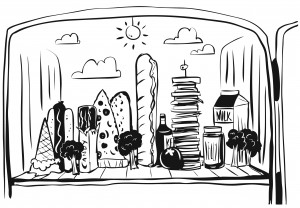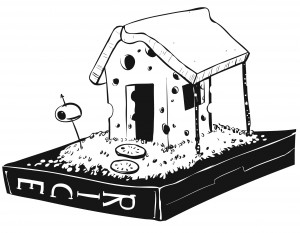
Foodscape
Consider the places and spaces where you acquire food, prepare food, talk about food, or generally gather some sort of meaning from food. This is your foodscape. The concept originated in the field of geography and is widely used in urban studies and public health to refer to urban food environments. Sociologists have extended the concept to include the institutional arrangements, cultural spaces, and discourses that mediate our relationship with our food.
Locating Foodscapes

A foodscape centers around a food environment. Where I live, my foodscape includes two grocery stores, a community garden, two food banks, several public school breakfast and lunch programs, multiple bodegas, a farmers’ market, food trucks, and several fast food restaurants. Although these are all within walking distance of my front door, foodscapes are not always proximate spaces. In many rural and urban areas, shoppers must drive or ride a bus to get to the nearest grocery store, restaurant or farmers’ market. In the suburbs of major cities, shoppers can find “big box” grocery stores that offer deep discounts and substantial choice. For middle-class shoppers, foodscapes extend to online spaces that allow consumers to order food from distant warehouses through grocery delivery services or websites like Amazon.com. The foodscape is never fixed; its boundaries shift depending on how the food environment expands and contracts.
A Multi-Faceted Analytical Lens
Sociologist Anthony Winson has written critically about the vast amount of processed foods and fast food restaurants clogging Canadian and U.S. foodscapes (as well as arteries). Reflecting on the so-called obesity “epidemic,” he identifies the profit-seeking motives of agribusiness, rather than consumer demand, as a primary force that has led to the dominance of “pseudo-foods” in many foodscapes. Consequently, healthy eating becomes the burden of the individual shopper who must learn to navigate their grocery store and neighborhood in search of healthy food.
Winson’s research is an example of a multi-faceted lens that captures the interplay of institutions and organizations, as well as spaces within foodscapes. Institutions, such as food assistance programs, and organizations like corporate grocers, play a fundamental role in determining the food we eat, as well as who eats and who does not. For children from low-income households, free school breakfast and lunch programs are integral to their foodscapes. Likewise, food banks and communal meal programs are vital components of the foodscape for many low-income individuals, particularly the elderly.
The institutional and organizational dynamics that contribute to a foodscape are often reflected in what kind of food is available. Mark Winne, a social activist working in New Haven, documents the struggles of poor, inner city residents who are at the mercy of the bodegas and small neighborhood grocery stores that serve their community, which are unlikely to carry affordable fresh produce and healthy food items. He also cites several examples of groups that have successfully convinced grocery stores to open in their neighborhoods. Winne’s work illustrates the inter-connections of corporate grocers and non-profit groups in both creating and responding to barren foodscapes.
Foodscapes reflect not just profit motives, but also racial prejudices. In her research on African American health, human ecologist Naa Oyo A. Kwate explores the ways in which fast food chains tend to target predominantly lower-income black neighborhoods in the United States. Grocers often need a lot of convincing to open stores in poor communities, especially those with high proportions of black and Latino residents. Referred to as “retail redlining,” this is a form of spatial discrimination whereby businesses choose not to locate a fresh food supermarket in an area that shows demand because of racial prejudices (e.g., that black neighborhoods have poor retail viability). Foodscapes are therefore classed and racialized environments.
The heterogeneity of foodscapes is not just a function of consumer demand. Healthy and unhealthy foodscapes owe more to deep-seated prejudices and the industrial food system’s hunger for profit than the spatial distribution of food cravings—those who desire hamburgers versus those with hankerings for kale chips.
Food Politics and Cultures

The contours of foodscapes are also shaped by cultural politics and trends about the meaning and significance of food. The slogan of “voting with your fork” is a powerful articulation of food politics and one that influences contemporary foodscapes. As a discourse, food politics draws from the ideals of the organic food movement of the 1960s and suggests that individual food purchases have the potential to transform the industrial food system into one that is more ethical, healthy and environmentally sustainable. This discourse encourages eaters to be more ethical consumers by supporting local farmers, organic production, and fair labor practices. Physical spaces such as farmers’ markets and Whole Foods Market, and cultural spaces like Michael Pollan’s book The Omnivore’s Dilemma and the documentary Fresh reflect the discourse of food politics. And online commercials and an upcoming TV series produced by the fast food chain Chipotle suggest that the discourse is expanding.
In our own research, my colleagues and I have found that the discourse of food politics has been incorporated into a new foodscape: the corporate-organic foodscape. Over the past dozen years, global food processors like Heinz, ConAgra, and Kraft Foods have acquired a significant proportion of the original organic food brands. The marketing of these products draws on key themes related to food politics. A box of cereal from Cascadian Farm (owned by General Mills), for example, shows an image of the lush Skagit Valley in Washington State to highlight how production happens within “local” spaces. The packaging includes a narrative about the dedication of its founder to the principles of organic agriculture. These discursive techniques, along with an industry structure of corporate ownership make this a corporate organic foodscape. At first glance, this appears to be a promising outcome of current food politics, but as long as it maintains the organization and logic of the industrial food system, it will be at odds with food-based social movements that focus on local environmental sustainability, food security and workers’ rights.
In their book Foodies, sociologists Josée Johnston and Shyon Baumann explore the narratives of the gourmet foodscape. As cultural omnivores, foodies mark their distinction from other eaters by highlighting their love of both highbrow dishes like truffles and foie gras and lowbrow favorites like hamburgers and chicken wings. Whether high- or lowbrow, they note that the gourmet foodscape requires the creation of boundaries that mark certain foods as exotic or authentic, and reinforces a dichotomy of “good” versus “bad” food.
The gourmet foodscape is also constructed through popular culture, including magazines like Bon Appétit websites such as Chowhound and food television. Food Network, for example, broadcasts dozens of shows in any given week, from Diners, Drive-ins and Dives (a show highlighting various working-class eateries) to Chopped (a show featuring competing chefs). Food trucks and food festivals in urban areas are also part of this foodscape. Their menus and branding blend the highbrow with the lowbrow, and produce messages about the authenticity or exoticism of their dishes. For example, the ramen burger (a meat patty encased by fried ramen noodle ‘buns’) that debuted at the 2013 Smorgasburg food fair in Brooklyn, and the Cronut (a croissant doughnut) are just a couple of the many new food “inventions” to come out of the gourmet foodscape.
Foodscape Horizons
Several foodscapes beckon the sociology of food. Groups interested in creating alternative foodscapes that use more democratic food distribution systems and involve communities of eaters with similar values and goals are growing as a response to the corporate-organic foodscape. These groups are taking the form of food policy councils, community gardens, food cooperatives, and community-supported agriculture. Digital and online spaces are another component of foodscapes that deserve more attention. In what ways do food blogs and applications like Instagram (where eaters upload photos of dishes they made or are about to eat) mediate our relationship to our food and the places where we get our food? Finally, as more and more affluent grocery shoppers simply log-on and “add to cart,” does online food shopping further stratify an already uneven foodscape? Eating is political. Identifying and analyzing foodscapes illuminates connections between food and social inequality.
